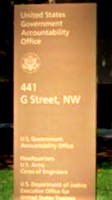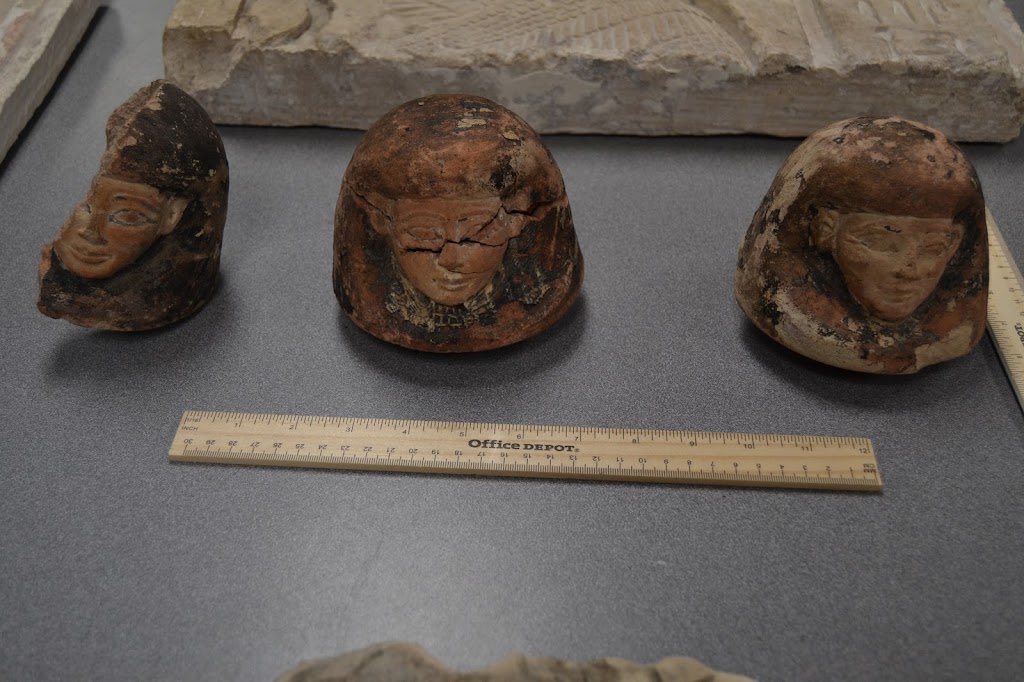Government Watchdog Says Goals Lacking for Key Cultural Heritage Committee; State Department Pledges to Fix Problem
“[W]e found that there was no consensus and no clear delineation of the specific roles and responsibilities of the entities on the CHCC and its working groups.” – GAO
The Cultural Heritage Coordinating Committee (CHCC) is “the principal body for coordination and implementation of cultural heritage protection and preservation initiatives across the U.S. government.” That’s how the U.S. State Department characterized the CHCC at a G-7 cultural ministers summit in March. Yet Congress’ independent watchdog, the General Accountability Office (GAO), finds that the CHCC lacks goals and has failed to clarify participants’ roles.
The CHCC is the federal interagency committee set up last year when Congress authorized import restrictions on at-risk cultural property from war-torn Syria. Signed into law by the president in May 2016, the bipartisan backed Protect and Preserve International Cultural Property Act suggested the creation of a cultural property coordinating committee, which lawmakers found to be an acceptable alternative after Congress failed to create a cultural property czar.
Congress fashioned the CHCC as a voluntary executive branch interagency committee, chaired by a State Department employee with the rank of assistant secretary or higher, and populated with representatives from “the Smithsonian Institution and Federal agencies with responsibility for the preservation and protection of international cultural property,” according to the terms of the International Cultural Property Act.
To learn more about the coordinating committee’s agenda and membership, CHL filed a Freedom of Information Act request last year. The State Department recently replied that it would fulfill this request by February 28, 2018. In the meantime–and what’s better–auditors at the GAO completed their own report.
Published in September and titled Iraqi and Syrian Cultural Property: U.S. Government Committee Should Incorporate Additional Collaboration Practices, the GAO report describes some positive attributes of the coordinating committee, observing that the CHCC “has followed key practices of identifying leadership; including relevant participants; bridging organizational cultures, such as agreeing on common terminology; and addressing resource issues. Most participants also reported that the CHCC was a helpful forum for sharing information.”
But the GAO report also states pointedly that “we found that there was no consensus and no clear delineation of the specific roles and responsibilities of the entities on the CHCC and its working groups.” The agency’s examiners write that “representatives of one entity leading a working group described their role in initiating working group meetings, and planning and circulating meeting agendas. However, most CHCC participants said that they are unclear about their specific roles and responsibilities for CHCC, including [the Department of Defense] and [the U.S. Agency for International Development], whose representatives on the CHCC were unable to describe their roles and responsibilities on the full committee and its working groups.”
The State Department says that it intends to fix these problems, according to the GAO.
The CHCC officially met for the first time on November 4, 2016, following an informal gathering in June 2016. According to the GAO report, in attendance at the November 2016 meeting were unidentified representatives from State, the Department of Homeland Security (Homeland Security), the Department of Justice (Justice), the Department of the Treasury (Treasury), the Department of Defense (Defense), the Department of Interior (Interior), the U.S. Agency for International Development (USAID), the National Endowment for the Humanities (NEH), and the Smithsonian Institution (Smithsonian). CHCC members met again in March and June 2017.
GAO examiners write in their report, “For the first CHCC meeting in November 2016, State invited nine federal entities to participate and requested that these participants volunteer for the working groups. Representatives of these nine federal entities all attended and, with the exception of USAID, have attended at least one additional meeting since the committee’s inception.” Regarding USAID’s future participation, “In July 2017, a USAID official informed us that USAID does not expect to participate in the CHCC.”
The GAO report identifies three concrete problems faced by the coordinating committee. “First, the CHCC and two of its three working groups have not developed short- and long-term goals.” Second, “the CHCC has not clarified participants’ roles and responsibilities on the committee or its working groups.” Lastly, the report finds that “CHCC participants have not documented agreements related to collaboration, such as developing written materials to articulate common objectives,” commenting that doing so “could help participants work collectively, focus on common goals, and organize joint and individual efforts to protect cultural property….” The GAO’s auditors more fully explain:
In the first formal meeting in November 2016, the chair of the committee articulated that the CHCC’s role was to coordinate antitrafficking efforts and to tackle a wide range of cultural heritage challenges worldwide. However, subsequent to that meeting, the CHCC has not produced documents identifying specific CHCC outcomes or goals. CHCC participants also indicated that no clear consensus on the CHCC’s stated goals has emerged from CHCC meetings. Many CHCC participants noted that the CHCC had not developed short-term and longterm goals, with some adding that the CHCC was working on doing so. Other officials had different views of the short-term and long-term goals. For example, one participant stated that a short-term CHCC goal was to establish working groups and understand the roles of the different entities, while another participant said that a long-term goal was to solidify information sharing among participants.
The GAO’s critique of the CHCC might explain why Treasury, Defense, and USAID have not been active participants in the working groups. The auditors describe how these agencies “stated that they did not volunteer for and have not participated in the new working groups because they did not clearly see how their entities could contribute to the topics of focus.” In fact, “most CHCC participants said that they are unclear about their specific roles and responsibilities for CHCC,” according to the GAO report.
In 2016, the CHCC established two working groups, one called Technology and one called Partnerships and Public Awareness. The coordinating committee also absorbed the existing intergovernmental Cultural Antiquities Task Force (CATF), transforming it into a third working group under CHCC’s umbrella.
The Technology working group reviews the “application of new and existing technologies to combat cultural property trafficking,” explains the GAO report, and the working group is chaired by someone at the FBI, part of the Department of Justice. Other members, all unidentified by the GAO report, include representatives from State, Homeland Security, Interior, NEH, and the Smithsonian. The group met in February and May 2017.
The Partnerships and Public Awareness working group, meanwhile, “focuses on public outreach and public-private partnership.” It too met in February and May 2017 and is chaired by an unidentified representative from the Smithsonian and includes unknown persons from State, Homeland Security, Justice, Interior, and NEH.
The GAO notes that the Partnerships and Public Awareness working group’s May meeting included participation from the National Endowment for the Arts, the National Archives and Records Administration, and the President’s Committee on the Arts and Humanities. “According to Smithsonian officials, the Smithsonian also invited the Library of Congress, the Institute of Museum and Library Services, the National Science Foundation, DOD’s National Defense University, and the Wilson Center to participate ….” However, the GAO observes that “the CHCC has not clarified the roles and responsibilities of the additional federal entities … including whether these entities would be members of the full committee or participants of only one CHCC working group,” adding that the “CHCC full committee meeting in June 2017 did not include these additional federal entities as invitees.”
CATF, an established stand-alone task force operating since 2004, is CHCC’s third working group. It “focuses on efforts to support local governments, museums, preservationists, and law enforcement to protect, recover, and restore cultural antiquities and sites worldwide, particularly in Iraq and Afghanistan,” according to the GAO. In the past, CATF worked with and funded activities supporting Justice, INTERPOL-US National Central Bureau, FBI, and Homeland Security to battle antiquities trafficking.
CATF met in June 2016 and again in June 2017. It is chaired by State and has members from Homeland Security, Justice, Defense, Interior, and Treasury’s Internal Revenue Service. Of significance, “State officials explained that [Defense] had been invited to CATF meetings in the past but had not participated extensively,” the GAO report indicates, and “[a]ccording to the [Defense] representative on the CHCC, [Defense] had not participated in the CATF in years but attended the CATF meeting in June 2017,” which was hosted by the Criminal Division at Justice.
A recent legislative measure that would spur greater CHCC participation by Defense is H.R. 2810, the National Defense Authorization Act, adopted by the House of Representatives on November 17. It instructs the Secretary of Defense “to designate an employee of the Department of Defense to serve concurrently as the Coordinator for Cultural Heritage Protection” and requires the Coordinator to be responsible for “coordinating with the Cultural Heritage Coordinating Committee convened by the Secretary of State for the national security interests of the United States, as appropriate.”
GAO conducted its audit of the CHCC by reviewing “meeting agendas, lists of invitees and attendees, and meeting notes for the CHCC and its working groups produced between November 2016 and June 2017, as well as “working documents resulting from the committee and its working groups.” The auditors also interviewed “U.S. federal entities that participated in the CHCC’s first meeting in November 2016.”
Text and original photos copyrighted 2010-2017 by Cultural Heritage Lawyer, a blog commenting on matters of cultural property law, art law, cultural heritage policy, antiquities trafficking, museum risk management, and archaeology. Blog url: culturalheritagelawyer.blogspot.com. Any unauthorized reproduction or retransmission without the express written consent of CHL is strictly prohibited. Visit www.redarchresearch.org.


